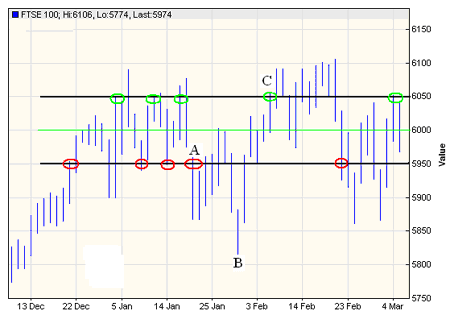
Last week I watched with bewilderment as the FTSE traded straight back to its key 6,000 level.
It was a remarkable event. No matter the obvious economic tailwinds, the FTSE just seems desperate to punch through the resistance it’s finding at just over 6,000. In fact on Friday, we hit just over 6,050 before terrible US employment data hammered it back down under 6,000.
I’m still inclined to short the FTSE at anything over 6,050. In fact, the chart is looking great for a short; and this time I want even more profit on the trade.
Keep it simple
The trade we’ve used over the last few months to gather in some quick and easy profits uses some very elementary charting techniques. We’ve not got too carried away with all the technical wizardry available.
In my experience, it’s just as well to keep it simple. That way there’s less that can be misinterpreted. Two simple tramlines are all you really need.
Here’s the original chart I showed you back in March:
Three-month FTSE 100 high-low chart
Source: Digital Look
Having noticed the key 6,000 level early, I drew two tramlines at 6,050 and 5,950. I reasoned that going long at 5,950 (red circles) and selling out at 6,050 (green circles) for a quick 100 point profit was a good bet.
But as the year drew on, I became more sceptical about the markets. I didn’t like the idea of going long the FTSE at all. So I suggested using exactly the same trade, only this time, we’d short the market at 6,050 and buy back in at 5,950.
And we didn’t have to wait very long to pick up our 100 point profit. In fact the recent down-draft plunged the FTSE back down to under 5,700. Wow… if we’d held that short open, we could have made a fortune!
And that’s got me thinking. Right now the chart is looking very different to how it looked at the beginning of the year. Together with 6,000, now 5,700 is another key level for the FTSE.
With trading, you need to constantly re-evaluate the chart and find the patterns that can help you to a profit. I’ve left in the old tramlines (in black) but I’ve now drawn in a new red line at 5,700.
Six-month high-low chart for the FTSE 100
I’m sure you can see where I’m going with this.
I’m no longer satisfied just picking up 100 point rewards on my short positions at 6,050. I’ve widened my ambitions and I hope to pick up 350 points.
Shorting the market at 6,050 (green circles) with a view to buying back in at 5,700 (red circles) is a pretty audacious trade. At £10 per point, we’re looking to make £3,500 (350 x £10) on each cycle.
I’d be looking to place a stop loss at 6,150. So if I’m wrong and the market punches through its resistance level, we’d lose 100 points (or £1,000 at £10 a point).
I’m only sorry that I didn’t send you this article on Friday. If you’d have opened the trade then, you’d already be sitting on 70 points profit now (the market’s down to 5,970 as I write).
What you should do now
The fact that the market has already come off puts us in a quandary. You can either wait and hope the market goes back up to 6050 and then open your short. Or, you can open a short at the current price and accept a smaller profit (and bigger potential loss).
Personally, I’d wait. Have a strategy and stick to it. Open a limit trade to sell the FTSE 100 at 6,050. Set your stop loss at 6,150. Once opened, place an order to close the trade (ie buy back) at 5,700.
If the market doesn’t trade back up to 6,050 – well, at least you haven’t lost anything.
Only you can decide how many pounds per point you want to stake. £1 per point is equivalent to having £6,050 short exposure. So if you stake £10 per point, bear in mind that’s equivalent to about £60k exposure.
For most investors, the best way to place a short trade is probably with a spread. If you’re looking for a spread betting account, see our comparison page for lots of good incentive deals.
The other common way to do it is with a CFD (contract for difference). If you’re not familiar with this type of account. Find out all about CFDs here.
Please bear in mind that you can lose more money than you stake with a spread bet. This trade is not for the faint-hearted – as I said, we’re looking to make quite an audacious profit here.
But for me, I’m happy to have a short as a hedge for my long portfolio – if the market tanks, I’ll be very happy to see the profits ramping up on my spread bet.
• This article is taken from the free investment email The Right side. Sign up to The Right Side here.
Important Information
Your capital is at risk when you invest in shares – you can lose some or all of your money, so never risk more than you can afford to lose. Always seek personal advice if you are unsure about the suitability of any investment. Past performance and forecasts are not reliable indicators of future results. Commissions, fees and other charges can reduce returns from investments. Profits from share dealing are a form of income and subject to taxation. Tax treatment depends on individual circumstances and may be subject to change in the future. Please note that there will be no follow up to recommendations in The Right Side.
Managing Editor: Frank Hemsley. The Right Side is issued by MoneyWeek Ltd.
MoneyWeek Ltd is authorised and regulated by the Financial Services Authority. FSA No 509798. https://www.fsa.gov.uk/register/home.do